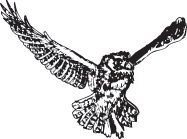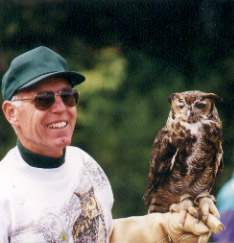

Great Horned Owl
(Bubo virginianus)
The Great Horned Owl is the fiercest and most aggressive owl of North America. Few birds of prey use their strength and aggressiveness with the intensity that the Great Horned Owl shows in defending its young and its territory. Here is a bird of prey capable of killing animals up to the size of porcupines and geese in both night and daylight hours. This is the only bird of prey which will regularly kill and eat skunks.

The Great Horned Owl is a nocturnal hunter, but also is commonly seen on the wing at almost any time of night or day. On cloudy days, it soars high on motionless wings and it is usually mistaken for a immature eagle. In winter, Great Horned Owls cache (store) some of their prey and later sit on it, incubating it, to thaw it out.
Great Horned Owls are almost never seen in pairs except during the mating season, and then only briefly. The female Great Horned Owl is decidedly the larger bird.
Great Horned Owls have the largest eyes of all North American owls. They give warnings to unwanted visitors by loud hiss and bill-snaps which can be heard 30 to 50 yards away. Their territorial song is a series of four or five deliberate, deep hoots. The Great Horned Owl and the Red-tailed Hawk often inhabit and hunt the same territory--the owl by night and the hawk by day.
The nest of the Great Horned Owl is usually an abandoned nest of a Red-tailed Hawk. The female usually lays two eggs and incubated them. The Great Horned Owl is essentially non-migratory, although severe winters may force some slight movement when prey becomes scarce. Hatching in late winter, cannibalism and severe weather are some of the causes of high infant mortality. For all intentions and purposes, once the Great Horned Owl becomes an adult, it has no natural enemies which are any real threat to it. Only man proves to be an enemy who can, and frequently does, kill the Great Horned Owl. Its benefits to man in checking the numbers of rodents far outweigh the occasional predation on game birds.